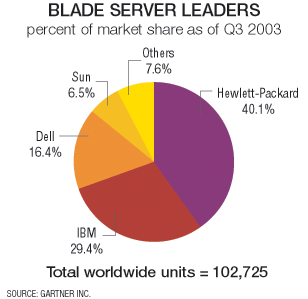|
Blade servers pierce the market
2004 seen as a breakout year for new
computing form factor
Bill Roberts --
, 2/1/2004
Despite the beginnings of an economic turnaround, corporate
IT spending in 2003 did not pick up as fast as the electronics
industry would have liked. One bright spot, however, was the
rate at which blade server sales accelerated, setting the
stage for a significant market ramp-up in 2004.
Blade servers are sleek, ultrathin modular packages, each
containing a CPU, memory and networking I/O, that slide into a
small chassis outfitted with power, cooling, network switches
and management features shared by all the blades, usually 12
to 16, depending on the vendor's design. The sharing of
resources is one big element in cutting both hardware and
management costs.
Analysts say that blades offer what IT executives are
looking for: a technology that cuts costs and consolidates
operations. But before the blade server market soars, analysts
say, the electronics industry must address the need for
standards, improve blade server management software and
provide evidence of the total cost of ownership (TCO).
This new form factor is the next evolutionary step in
server computing, according to vendors. Blade servers, which
debuted two years ago, consume about half as much space as
comparable rack-mounted servers. And IBM estimates that its chassis, which hold 14 blades, use 83
percent less cable than comparable rack-mounted server
offerings. A blade server chassis can also hold storage and
networking blades—some call it a data center in a box.
International Data Corp. estimates that 52,000 blade
servers were sold worldwide in the third quarter of 2003 and
forecasts 200,000 for all of 2003. Blades are still a thin
slice of the total worldwide server market, which IDC
forecasts to be 5.2 million units in 2003. But the blade
market has grown steadily from a mere 10,000 units in the
third quarter of 2002.
"By 2007, we expect blade servers will be about 2.3 million
units out of a total of 8.4 million units," says Mark
Melenovsky, an IDC analyst. IDC forecasts that the worldwide
server market will grow from $49.2 billion in 2003 to $57
billion in 2007.
"This is the fastest-ramping server in our history," says
Tim Dougherty, director of blade server strategy for IBM. "We
far exceeded what we thought we would do in 2003." IBM entered
the market later than Hewlett-Packard, which
is the market share leader (see the graphic "Blade Server
Leaders").

IBM and Intel have been working together
to develop blade servers since mid-2002. Intel also offers a
complete blade server package, including some software, to its
channel partners. Patrick Buddenbaum, Intel's blade server
product line manager, says that 10 OEMs were shipping blade
servers by the end of 2003 and that many others will begin in
2004.
Anil Vasudeva, chief analyst at Imex
Research, estimates that 140 companies, including OEMs, chip
companies and software developers, are involved in some aspect
of the market. He says that blade servers were originally
developed for Internet service providers, because the
architecture reduced the real estate that ISPs needed for
housing thousands of servers.
Vasudeva
says blade servers have made their way into research settings
and are now finding corporate applications in the banking and
retail markets, in online transaction processing and analysis
and in applications that require streaming video. He expects
blade servers to host many data center applications in the
future.
Vasudeva
says blades are ideal for data centers because they offer
maximum flexibility. With management software available now, a
server administrator can automatically configure blade servers
for online transaction processing during a bank's open hours
and automatically switch to back-office tasks overnight.
Trying to manage racks of servers for the same purpose
requires a lot of plug switching.
Software is the key, Vasudeva says. All major
vendors—IBM, HP and Sun Microsystems—offer
management software, but Vasudeva foresees a robust blade
server software business as innovators find new and better
ways to manage and extend the use of blades.
RLX Technologies offered the first blade
servers, in 2002. Its management software, Control Tower XT,
is what sets that company apart, according to Jeffrey Hewitt,
an analyst at Gartner, who notes, "I would have to give its
software an edge, from what I've seen." Hewitt says that OEMs
need to establish blade standards the way they did for
rack-mounted servers. Although blade chassis from different
vendors can interoperate, the blades and other components
cannot be moved from one vendor's chassis to another. Hewitt
believes that users will eventually want more flexibility to
mix and match blades and chassis.
Hewitt and others say that the industry also needs to start
providing TCO evidence to convince potential buyers that
blades are a better purchase than rack-mounted servers. In
just one area—IT staffing—customers of RLX Technologies
anecdotally report that they need fewer administrators to
manage blade servers. Industry benchmarks typically put the
ratio of administrators to servers at one to between 30 and 50
in a rack-mounted environment. With blades, according to Paul
Barker, RLX vice president of marketing, one administrator at
RXL's customers can handle 350 or more servers.
| 



